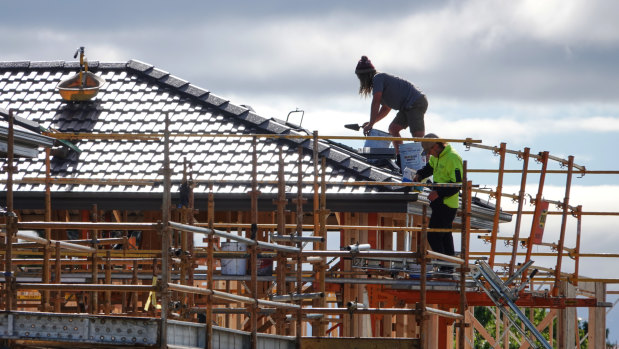This was published 8 months ago
High interest rates erode households’ ability to borrow and build
Australia’s builders are suffering a three-speed market as high interest rates erode households’ ability to borrow and build dwellings, major home builders say.
Housing Industry Association data released on Thursday shows sales of new homes rose nationally by 5.3 per cent in February. The organisation tracks the country’s largest volume home builders which report sales are still low, at levels seen in the second half of last year.

February’s increase in new homes sales follows a weak January.Credit: Paul Rovere
February’s increase in sales follows a weak January when housing approvals monitored by the Australian Bureau of Statistics fell about 10 per cent from the previous month and nearly 5 per cent over the year in seasonally adjusted terms.
The HIA said high interest rates are eroding households’ ability to borrow, and eating into the market’s confidence. The official cash rate has jumped from just 0.1 per cent in May 2022 to 4.35 per cent now, less than two years later.
Banks are now charging mortgage holders variable interest rates around 6 per cent.
“It’s a three-speed housing market,” said Antony Blackshaw, chief executive at Henley Homes, which averages between 1800 and 2200 new starts a year but has seen sales drop around 25 per cent this year.
Perth is relatively active and affordable, Queensland and South Australia are trading quite strongly whereas New South Wales and Victoria are the “most challenged from an affordability point of view,” Blackshaw said.
“They’re the ones that don’t quite have the demand,” he said.
HIA chief economist Tim Reardon said on Thursday that slowing sales and building approvals will flow through to a decade-low volume of new houses commencing construction in 2024.
“The economic impact of this slowdown will become increasingly evident in 2024, as employment in the home building industry falls,” he said. “Higher borrowing costs are compounding the elevated cost of land and construction, drying up the pipeline of new home building work despite the significant pent-up demand for housing.”
Rob Douglas from Nex Building Group said the group saw “fairly strong inquiry” in January and February, up about 20 per cent compared to the same time last year, but no increase in prospective homeowners moving forward and paying deposits.
Nex has a big presence in Sydney, constructing dwellings under the McDonald Jones, MOJO, Brighton, Arden, Wilson and Weeks Homes brands.
“For the last 18 months, consumer confidence has been very low with the many interest rate rises that we’ve had. It’s just another layer that prevents buyers from moving forward with what their home aspirations are,” Douglas said.
Nex started construction on about 2400 homes last year. This year that number has halved. “We forecast where the market was going. We’ve always taken a conservative approach, so we readjusted our overhead structure accordingly,” he said.
The company lists Japanese behemoth Asahi Kasei Homes as a majority 40 per cent owner, giving it the financial heft to manage the current slowdown.
Two years ago, a surge of new home orders triggered by record-low loan costs and the former Coalition federal government’s HomeBuilder incentive scheme created a world of pain for builders, who were crunched between fixed-price contracts signed with customers before the global pandemic and soaring cost inflation as the world kicked back into gear after the crisis.
The result was a string of high-profile builder collapses including Victorian and Queensland volume builder Porter Davis which rocked consumer confidence in the industry.
“Some people have probably changed their plans and bought established houses because they’re worried,” Blackshaw acknowledged, adding “we’re hearing less noise about that now.”
“Builders are finding ways to really highlight to the public that they’re financially sound,” he said.
Any downward move in interest rates is likely to spur building.
“Once we are certain that interest rates won’t go up ... people will then start to say right, now it’s time for me to make my housing decision,” Blackshaw said.
He expects demand to lift either in the second half of this year or the first half of 2025. “I don’t think we’re in for a prolonged drop in activity. I think it will be 12 to 24 months,” he said.
The Business Briefing newsletter delivers major stories, exclusive coverage and expert opinion. Sign up to get it every weekday morning.